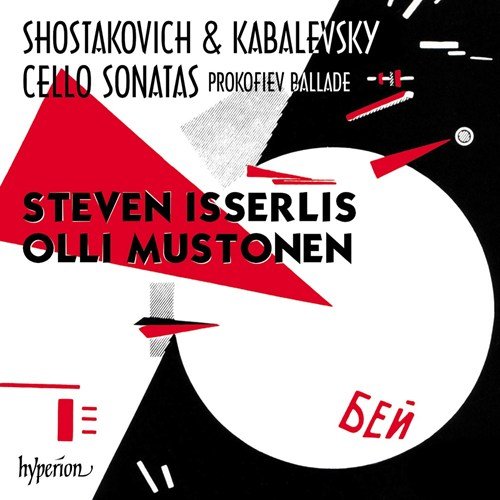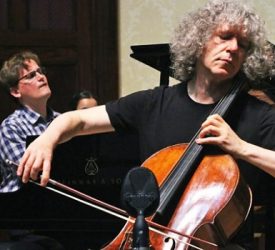Classical CD Reviews: Paul Lewis Plays Weber and Schubert, Steven Isserlis and Olli Mustonen Serve Shostakovich
By Susan Miron
Two highly recommended recordings by well-known artists performing some rather off-the-beaten-path repertoire.

British pianist Paul Lewis, a favorite of Boston (and Tanglewood) audiences, has won numerous accolades for his recordings of Schubert, Haydn, and Beethoven. A year after his eloquent account of sonatas composed in Haydn’s late middle-age, the pianist gives his customary elegant yet exciting treatment of music written during the early nineteenth century. This (Harmonia Mandi) disc contains youthful works by two composers who would not live to see 40: Schubert’s Sonata D.575 from 1817 and Weber’s Second Piano Sonata of 1814. Both men suffered early, tragic deaths (Weber of tuberculosis at the age of thirty-nine in 1826 and Schubert of advanced-stage syphilis at age thirty-one in 1828). Ironically, both were in relatively good health and beginning to enjoy some success for the pieces included on this recording. Both composers are, of course, better known for their brilliant vocal writing — Weber for his operas and Schubert for his Lieder. (Lewis has made three acclaimed recordings of Schubert’s songs cycles with tenor Mark Padmore.)
While Schubert’s Sonata D. 575 is among his only-occasionally played sonatas, the four sonatas of Weber are rarely recorded or, for that matter, performed live. In the hands of Lewis, Weber’s Sonata No. 2 is a total delight. He was a pianist, and wrote — who knew? — a large amount of piano music, including his four sonatas, which are (perhaps) the first really large-scale, virtuosic Romantic piano sonatas, pieces that were influences on Schumann and Mendelssohn.
Joseph Morgan’s informative liner notes set up the contrast between the composers: “In 1816 Schubert had focused on music for voice (songs and opera) as well as the symphony. Although he had not yet received a publication, public performance or even mention in the Viennese papers, he had achieved a very clear, mature Romantic compositional voice. In 1817, he turned to the piano, and wrote some of his most important compositions for that instrument, completing no fewer than seven sonatas for piano as well as a Violin Sonata (D 574) and his Sixth Symphony (D 589). Indeed, Schubert served as an assistant to Weber during the next decade while Weber was organising the premiere of his penultimate opera, Euryanthe (1823). During this time Schubert criticized Weber’s opera for his inability to unify vast chromatic sections, stating: ‘There are clumsy masses which Weber cannot control.’ That Schubert would attack Weber for this is probably a reflection of where the younger composer’s strengths lie. Of course, on the other hand, Weber’s genius for the authentic depiction of drama, as well as his adherence to Classical expression, reflects the reason why his operatic compositions received so much more attention than those of Schubert. Taken as a whole, this collection presents a unique view of early nineteenth-century piano composition that rarely gains attention.”
For me, Lewis never, ever, disappoints. During repeated hearings of this CD, I was repeatedly entranced by the grace and lyricism of his playing, which is exactly what I felt listening to Lewis’s Haydn, Beethoven, and other Schubert. It is no wonder this was Presto’s Recording of the Week for Feb. 15.

Lewis’s poetic imagination and inspired musicianship is shared by the artists performing Shostakovich and Kabalevsky Cello Sonatas (Hyperion), cellist Steven Isserlis and pianist/composer Olli Mustonen, who have been musical partners for decades. I adore this CD, which was my first real introduction to these excellent players, although I was familiar with their recording of Shostakovich Trios with violinist Joshua Bell. This new disc contains a brilliantly conceived and played program. If nothing else, it serves as a wonderful introduction to Shostakovich’s monumental Cello Sonata in D minor.
There is no shortage of recordings of Shostakovich’s Sonata in D minor for Cello and Piano, Op. 40 (1934), which Isserlis considers to be the most important work for the instrument produced in the twentieth century. Written during an emotionally tumultuous moment in his (love)life, Shostakovich penned the piece for his supporter and friend, cellist Viktor Kubatsky, shortly before the success of the composer’s opera Lady Macbeth of Mtsensk. During a period in 1935, this opera was performed in three Moscow theaters simultaneously. The composer’s good fortune ended rather abruptly after Stalin finally heard the work; he was unamused by its modernity and lurid depictions of murder and adultery.
A rather able pianist, Shostakovich premiered his Cello Sonata in Leningrad on Christmas Day, 1934, alongside cello sonatas of Grieg and Rachmaninov. The composer reportedly performed the piano parts to all three works from memory.
Shostakovich’s Cello Sonata has since become the lodestar of the 20th century cello repertoire. Its genesis was hopelessly entangled, in the summer of 1934, with the 28 year-old composer falling madly in love with a 20 year-old translator, Yelena Konstaninovskaya. Much to the dismay of his wife Nina (despite their mutual agreement to an open marriage), the composer spent the majority of their summer holiday writing letters to his young mistress. “There is nothing in you which fails to send a wave of joy and fierce passion inside me when I think of you,” he wrote, “I love you so, I love you so, as nobody ever loved before. My love, my gold, my dearest, I love you so; I lay down my love before you.”
Shostakovich and Nina separated; the composer remained in Moscow with no plans to follow his wife back to Leningrad. It was during this time that work on the Cello Sonata began. By 1935, however, Nina was pregnant with the couple’s first child, and the marriage essentially righted itself (though that did not preclude later extramarital affairs by both Dmitry and Nina). Shortly after the affair ended, Konstaninovskaya received an anonymous political denunciation and spent roughly a year in prison.

Steven Isserlis and Olli Mustonen in performance. Photo: courtesy of the artist.
Isserlis and Mustonen also perform Dmitri Kabalevsky’s (1904–1987) far less well-known Cello Sonata, Op 71. Like so many important Russian compositions, the piece was written for cellist Mstislav Rostropovich, who premiered it with the composer at the piano in 1962. In his notes, Isserlis describes the work as “a roller-coaster of emotions: intense gloom is violently contrasted with outbursts of manic energy. The second movement—‘the waltz that never was’, as Rostropovich used to describe it… —is a ghostly ‘danse macabre’, full of skeletally grotesque effects. The finale is an electrifying perpetuum mobile, returning only in the coda to the shadows of the sonata’s opening. I find it surprising that this sonata is not heard more often; both Olli and I find it quite masterly—and addictive.”
In the words of Isserlis, another Kabalevsky piece, “Rondo in memory of Prokofiev,” Op. 79 (1965), is “the third of three Rondos that Kabalevsky wrote as test-pieces for the Tchaikovsky Competition in Moscow, the first having been for piano in 1958, the second for violin in 1962. The present one was composed in 1965, which should have been Prokofiev’s seventy-fifth year; without (as far as I can tell) overtly quoting from Prokofiev’s works, Kabalevsky pays homage to the older master by conjuring up the spirit of balletic elegance and martial vitality, punctuated with episodes of frenetic activity and wind-over-graves whispering, that we associate so strongly with Prokofiev’s music. Whatever their personal relationship may have been, this is a handsome tribute from one composer to another.”
Prokofiev began work on his ballet Cinderella in 1941; due to the difficulties of wartime productions, however, the work did not receive its first performance until late 1945. The year before that, the composer arranged this touching Adagio — which largely features orchestral cellos in the original — for cello and piano. ‘The main thing I wanted to convey in the music of Cinderella, wrote Prokofiev, “was the poetic love of Cinderella and the Prince.” This Adagio accompanies the couple’s first, ecstatic dance together — it was my favorite new discovery on this recording.
The rest of this CD contains shorter, yet affecting pieces. Mustonen has recorded a great deal of the piano music of Prokofiev, and here he and Isserlis play his Ballade in C Major.
If you are unfamiliar — or even if you are familiar — with this repertoire, you would be hard pressed to find better performances on either of these CDs.
Susan Miron, a harpist, has been a book reviewer for over 30 years for a large variety of literary publications and newspapers. Her fields of expertise were East and Central European, Irish, and Israeli literature. Susan covers classical music for The Arts Fuse and The Boston Musical Intelligencer.
Tagged: Harmonia Mundi, Hyperion, Olli Mustonen, Paul Lewis
